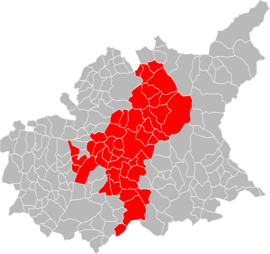Loading AI tools
Communauté d'agglomération in Alpes-de-Haute-Provence, France From Wikipedia, the free encyclopedia
The Communauté d'agglomération Provence-Alpes or Provence-Alpes Agglomération is a French agglomeration community, created on 21 October 2016 (with effect from 1 January 2017), located in the department of Alpes-de-Haute-Provence, in region Provence-Alpes-Côte d'Azur. Its seat is Digne-les-Bains.[1] Its area is 1574.0 km2. Its population was 47,382 in 2018, which is 29% of the population of Alpes-de-Haute-Provence.[2]
Provence-Alpes | |
|---|---|
 Location within the Alpes-de-Haute-Provence | |
| Country | France |
| Region | Provence-Alpes-Côte d'Azur |
| Department | Alpes-de-Haute-Provence |
| No. of communes | 46 |
| Seat | Digne-les-Bains |
| Government | |
| • President (2020–2026) | Patricia Granet-Brunello (DVG) |
| Area | 1,574 km2 (608 sq mi) |
| Population (2018) | 47,382 |
| • Density | 30/km2 (80/sq mi) |
It is one of the two agglomeration communities of the Alpes-de-Haute-Provence, the other being Durance-Luberon-Verdon Agglomération.
Law no. 2015-991 of August 7, 2015 on the new territorial organization of the Republic, known as the NOTRe law, imposed their own taxation on public institutions with a population between 5,000 and 15,000 for inter-municipal cooperation.[3]
The departmental inter-municipal cooperation plan (SDCI), unveiled in October 2015, proposed the merger of five communautés de communes: Asse-Bléone-Verdon, Pays de Seyne, Moyenne-Durance, Duyes et Bléone and Haute Bléone.[4]
The withdrawal of Saint-Julien-d'Asse from the community of municipalities, so that it joins Durance Luberon Verdon agglomeration community (also called the Manosquin pôle), having been rejected, no other modification was made after the meeting of the departmental intercommunal cooperation commission on March 21, 2016, following the adoption of the SDCI on March 25.[5]
The urban community was created by the prefectural no 2016-294-002 of 21 October 2016 with the name “Provence-Alpes Agglomération”.[6]
The agglomération community is located from north to south of the department of Alpes-de-Haute-Provence, in the arrondissement of Digne-les-Bains.
The agglomeration community is made up of 46 communes:[7][1][8]
Patricia Granet-Brunello (DVG) is the president of the community since 2017.[9][10]
| Name[11] | Party | Delegacy[12] | ||
|---|---|---|---|---|
| 01 | Patrick Martellini | PRG | Delegate for finance | |
| 02 | Francis Hermitte | PS | Delegate for tourism strategy | |
| 03 | Gilbert Reinaudo | DVG | Delegate for human resources | |
| 04 | Denis Baille | DVG | Delegate for jobs | |
| 05 | Patricia Brun | DVG | Delegate for the management of services of collective interest (sport and leisure, early childhood, etc.) | |
| 06 | Gérard Paul | PCF | Delegate for the collection, treatment and recovery of waste | |
| 07 | Bernard Teyssier | PS | Delegate for environmental spaces and outdoor facilities | |
| 08 | Emmanuelle Martin | DVG | Delegate for transport and mobility | |
| 09 | Philip Nicolosi | DVG | Delegate for economic strategy | |
| 10 | Claude Fiaert | PS | Delegate for culture and cultural facilities, coordination of events of community interest and communication | |
| 11 | Benoît Cazères | PS | Delegate for the pooling, development and evolution of skills, and evaluation of public policies | |
| 12 | Bruno Acciaï | DVD | Delegate for the attractiveness of the territory | |
| 13 | Patrick Vivos | DVG | Sustainable development delegate | |
| 14 | Gilles Chatard | DVD | Delegate to the citizen factory and the development council | |
| 15 | Philippe Pouleau | Delegate to SCOT and PLUI, Social balance of housing | ||
Seamless Wikipedia browsing. On steroids.
Every time you click a link to Wikipedia, Wiktionary or Wikiquote in your browser's search results, it will show the modern Wikiwand interface.
Wikiwand extension is a five stars, simple, with minimum permission required to keep your browsing private, safe and transparent.